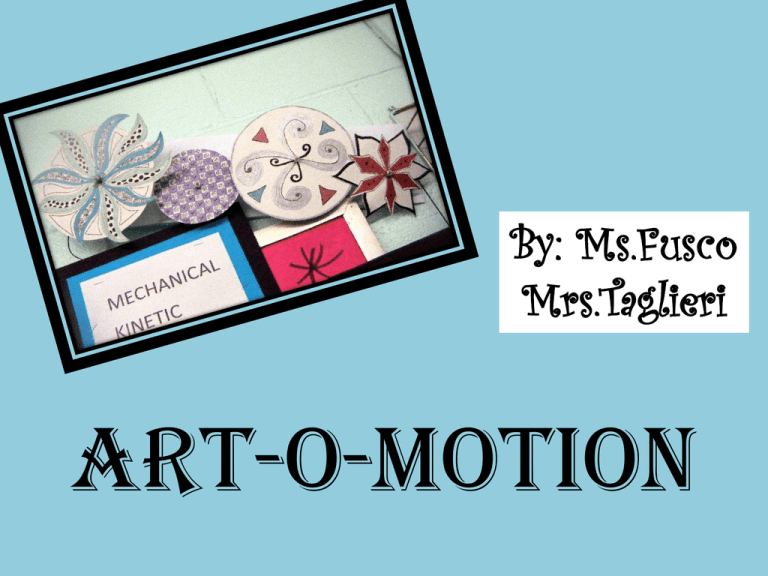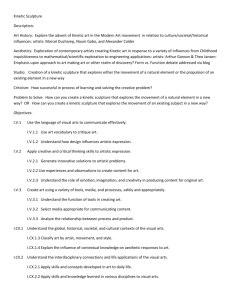ART-O-MOTION - personal.stevens.edu
advertisement

By: Ms.Fusco Mrs.Taglieri Art-o-motion STEAM Science Technology Engineering Art Math What Do Engineers Do ? Students research and explore the different types of engineers and what they do. Design Process • • • • • • Identify problem Brain Storm Design Build Test, Evaluate, and Redesign Share Solution Terminology DESIGN PROCESS – The steps that engineers use to arrive at a solution, solve the problem. BRAINSTORM • What are some different ways to tackle today’s challenge ? • Off-the-wall suggestions often speak GREAT ideas. How creative can you be ? DESIGN • Which brainstormed ideas are really possible, given your time, tools, and materials? • what are some problems you need to solve as you build you build your project/ • How can a sketch help clarify your design? BUILD • What materials will you need? • what can you learn by looking at other students’ projects? TEST, EVALUATE, AND REDESIGN • Why is it a good idea to keep testing a design? • What specific goal are you trying to achieve, and how will you know if you’ve been successful? • How does the design process meet the criteria for success presented in the challenge? SHARE SOLUTIONS • What’s the best feature of your design? Why? • What were the different steps you did to get your project to work? • What was the hardest problem to solve? • Did you have to do something a few times to get it to work? What? • If you had more time, how would you improve your project? • Students review the element of line. • Students will research the artist M.C. Escher and his art work • Review video Optical Illusions How to Create them. The Mathematic Element In Escher’s World students are able to think about mathematical ideas in an expressive way. Element of Design An element of art that is used to define shape, contours, and outlines, also to suggest mass and volume. It may be a continuous mark made of a surface with a pointed tool or implied by the edges of shapes and forms. Tools used to create designs are ruler, t-square, compass, protractor, circle template, and Sharpie marker. Science Element Kinetic Sculpture…… Kinetic art is art that contains moving parts or depends on motion for its effect. The moving parts are generally powered by wind, air, force of gravity or electricity…… Marcel Duchamp mounted a spinning bicycle wheel onto a stool to make what is considered the first kinetic sculpture. The wheel required the reaction of a viewer, but later experiments incorporated pulleys and motors to create motion. Kinetic art incorporates an element of mechanical or random movement, or gives the illusion of movement by the use of optical techniques Mobile kinetic sculptures The meaning of the term ”mobile” as applied to sculpture has evolved since it was first suggested by Marcel Duchamp in 1931 to describe the early, mechanized creations of Alexander Calder. At this point, “mobile” was synonymous with the term “kinetic art”, describing sculptural works in which motion is a defining property. NewtoN’s three Laws of Motion • • • Law 1 - An object moving in a straight line will continue moving in a straight line, unless acted on by an outside force. Also, an object at rest will stay at rest. Law 2 – Force will cause a change in the motion of an object. The change in motion depends on the amount of force and the mass of the object. There is a formula for this F=ma (force equals mass times acceleration). Law 3 – For each action, there is an equal and opposite reaction. • Force is a push or a pull • Motion is moving something from one place to another. • Speed is a scientific term that means the rate of motion, or how fast something travels or moves. • Gravity is a force that pulls everything toward the center of the Earth. • Weight is the measure of gravity’s force. Leonardo da Vinci Painter, sculptor, architect, mathematician, engineer, inventor…… Da Vinci is widely considered to be one of the greatest painters of all time and perhaps the most diversely talented person ever to have lived….. Coloring Aspect Color, Value and Hue Color is one of the most powerful of elements. It has tremendous expressive qualities. Understanding the uses of color is crucial to effective composition in design and the fine arts. The word color is the general term which applies to the whole subject - red, orange, yellow, green, blue, violet, black and white and all possible combinations thereof. Hue is the correct word to use to refer to just the pure spectrum colors. Any given color can be described in terms of its value and hue. In addition, the various physical phenomena and psychological effects combine to affect our perceptions of a color. Line also communicates emotion and states of mind through its character and direction Quality finished pieces of the Art Design Building process Assemblage- A 3-dimensional work of art made by joining objects together. To construct is to build or form by putting together parts, frame or devices. Art -In- Motion Special thanks to: Adam Scribner for this knowledge, patience and guidance for walking us through the STEAM experience. Steven Institute of Technology for offering this workshop to educators to broaden our students’ knowledge, as well as making the connection among Science, Technology, Engineering, Art and Math. Geraldine R. Dodge Foundation for giving Stevens the ability to offer a grant to make this wonderful workshop possible to educators. * A special thanks to Denise Peguero and Brandon Lyons for assisting in the creation of this power point presentation.











